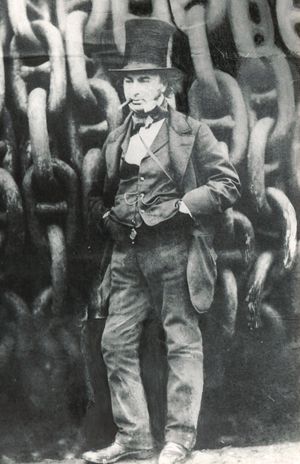Press Releases
Brunel in Wales Exhibition at the National Wool Museum
Date:
2013-08-15An exhibition of the works of Brunel in Wales will be at the National Wool Museum, Dre-fach Felindre from Saturday 17 August until Saturday 9 November, looking at the major rail, bridge and sea works built by the engineer Isambard Kingdom Brunel (1806 – 1859) in Wales.

An exhibition of the works of Brunel in Wales will be at the National Wool Museum, Dre-fach Felindre from Saturday 17 August until Saturday 9 November, looking at the major rail, bridge and sea works built by the engineer Isambard Kingdom Brunel (1806 – 1859) in Wales.
There is free entry to this exhibition, which concentrates on the ingenuity of Brunel in using engineering to overcome natural obstacles in transport systems, and covers Pembrokeshire to the Gwent borders of South Wales.
Some say that Isambard Kingdom Brunel was the greatest railway engineer of his age – arguably, of any age, having built twenty-five railways lines, over a hundred bridges, including five suspension bridges, eight pier and dock systems, three ships and a pre-fabricated army field hospital. His work in Wales reflects every aspect of Brunel's working life – railways, bridges, docks, even gigantic passenger ships.
Brunel was born at Portsea on 9 April 1806 and after working as an assistant engineer on his father's project to dig the world's first underwater tunnel, beneath the Thames in London was appointed chief engineer of the Great Western Railway in 1833. He had greater aims than simply constructing the line from London to Bristol. His idea was to extend the line into Wales.
Although the line to the east of Swansea was open by the summer of 1850, the western section was not completed for another six years but, when it finally opened, the two railways provided a direct link between London and the west.
There are many other Brunel connections in Wales. Notable among them is the bridge across the Wye at Chepstow, a construction raised on large cast iron piers. There is also the 37 span viaduct over the River Tawe at Landore in Swansea, the longest timber viaduct he ever built.
One of Brunel's most fascinating creations was the series of flying arches – just like flying buttresses on cathedrals – across the track at Llansamlet. Their intention was to prevent the flanking embankments sliding down onto the track in times of heavy rain or inclement weather.
He was also instrumental in designing the Taff Vale Railway, one of the main arteries for taking coal down the Rhondda to Cardiff. He was responsible for re-routing the River Taff away from what became known as Cardiff Arms Park, thus helping cure some of the drainage problems from which the area always suffered. The stone viaduct at Goitre Coed, crossing the River Taff, remains one of his most beautiful creations.
In 1851 Brunel designed the Vale of Neath Railway and, as part of this project, built the Dare Valley Viaduct which took coal down the Cwmdare Valley. Sadly, the viaduct was dismantled just after the second world war in 1947.
Brunel’s connections with Wales are significant even though he himself was not Welsh.
There is free entry to the National Wool Museum, which is open every day from 10am until 5pm over the summer and closed on Sundays and Mondays from October until March.